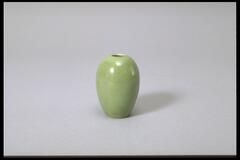Cabinet P: Shelf 2
Celadon Wares in Asia
Although Celadon is the term for a translucent crackle glaze applied to porcelain and stoneware, it has come to mean wares that are specifically greenish blue or gray in color, particularly those from China and Korea. The trademark greenish hues of celadon wares were achieved through the use of clays and glazes that contained small amounts of iron, which turns green in a reduction firing atmosphere. (When there is insufficient oxygen in the air in a kiln, oxygen molecules are pulled from the ceramics themselves; it is this change in chemical composition that changes the color of the ware.) The thickness of the glaze and type of clay determine the color after firing, and getting the “right” effect is extremely difficult. The thin watery glaze runs off high points in the design and pools in impressions, creating dazzling gradations in color, especially in incised and molded designs.
Jade was prized in East Asia, and the ability to imitate its color in porcelain was highly valued. In the Goryeo Period (918-1392) in Korea, a celadon ewer or teacup was more precious than gold or silver. The high estimation of celadon was not limited to Korea, but extended to discerning connoisseurs at the court of the Northern Song dynasty (960–1127) in China. Celadon was quite popular in Japan as well, where it was both imported and manufactured in a native version. Celadon is considered by many to have reached its height during the Goryeo period, and these wares continue to be prized by collectors today.
![<p>The lid of this jar is carved with lotus petal design, crowned with the knob shaped as a lotus bud. Three refractory spurs are stuck to the inside of the lid. The shoulder of the jar is decorated with a descending willow design inlaid with white slip. The entire foot and outer base are glazed, but it is poorly fused and rough with impurities stuck to it. The lid retains a celadon color, but the jar itself is a light gray hue overall.<br />
[<em>Korean Collection, University of Michigan Museum of Art </em>(2014) p.134]</p>
<p>The lid of this jar is carved with lotus petal design, crowned with the knob shaped as a lotus bud. Three refractory spurs are stuck to the inside of the lid. The shoulder of the jar is decorated with a descending willow design inlaid with white slip. The entire foot and outer base are glazed, but it is poorly fused and rough with impurities stuck to it. The lid retains a celadon color, but the jar itself is a light gray hue overall.<br />
[<em>Korean Collection, University of Michigan Museum of Art </em>(2014) p.134]</p>](/media/W1siZiIsIjIwMjIvMDkvMjQvN2FsdDhlMjE5eV9kZWZhdWx0LmpwZyJdLFsicCIsInRodW1iIiwiMjQweDIwMCJdXQ?sha=e14cf9abceae9ee5)
Covered Cosmetic Jar
stoneware with inlaid slip designs under celadon glaze
4 9/16 x 5 1/16 x 5 1/16 in. (11.5 x 12.8 x 12.8 cm);1 3/16 x 2 3/8 x 2 3/8 in. (3 x 6 x 6 cm);3 11/16 x 5 1/16 x 5 1/16 in. (9.3 x 12.8 x 12.8 cm)
Gift of Bruce and Inta Hasenkamp and Museum purchase made possible by Elder and Mrs. Sang-Yong Nam
Created For
K-12 EducatorK-12 Student
Museum Visitor
UMMA Docent
UMMA Staff
University Faculty
University Student
Rate this Resource
AVG: 0 | Ratings: 0
& Author Notes
Creative Commons by-nc-saLast Updated
June 8, 2020 1:01 p.m.Report
Reporting Policy
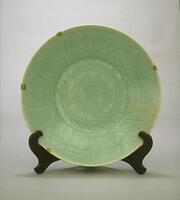

![<p>This bowl was produced between the late 12th and 13th century, when ornate decoration was accorded greater importance than the beauty of color. A small circle was incised at the inner bottom, surrounded by two concentric circles inlaid with white slip. On the inner wall are decorated four small medallions inside which are rendered chrysanthemum sprays. On both the upper part of the inner and outer walls are decorated a band of scrolls and a pair of horizontal lines, respectively. The low foot displays refractory spur marks. Glaze drips and cracks are visible in parts of the bowl’s surface.<br />
[<em>Korean Collection, University of Michigan Museum of Art</em> (2014) p.104]</p>
<p>This bowl was produced between the late 12th and 13th century, when ornate decoration was accorded greater importance than the beauty of color. A small circle was incised at the inner bottom, surrounded by two concentric circles inlaid with white slip. On the inner wall are decorated four small medallions inside which are rendered chrysanthemum sprays. On both the upper part of the inner and outer walls are decorated a band of scrolls and a pair of horizontal lines, respectively. The low foot displays refractory spur marks. Glaze drips and cracks are visible in parts of the bowl’s surface.<br />
[<em>Korean Collection, University of Michigan Museum of Art</em> (2014) p.104]</p>](/media/W1siZiIsIjIwMjIvMDkvMjQvNjk3YnprbTBpZ19kZWZhdWx0LmpwZyJdLFsicCIsInRodW1iIiwiMjQweDIwMCJdXQ?sha=d4cfc0a923163d52)
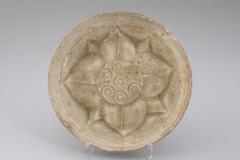
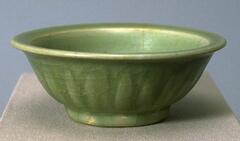
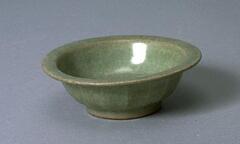
![<p>Displaying a good sense of overall balance, the bowl’s glaze is also quite clear and green. It was fired after the entire foot was glazed and placed on three quartzite supports. There are marks of glaze running on both the inside and outside of the bowl, leaving an uneven surface. Bowls fired on quartzite spurs such as this one were mostly high-quality items. Apart from damage in two parts of the mouth, this piece is preserved in near-perfect condition.<br />
[<em>Korean Collection, University of Michigan Museum of Art</em> (2014) p.98]</p>
It has a slightly outward flared rim and tapers abruptly to a narrow base. It has no underglaze decoration. There are three spur marks in eye. The glaze is greenish blue in color, leaning toward green, and the base clay contains some impurities. <p>Displaying a good sense of overall balance, the bowl’s glaze is also quite clear and green. It was fired after the entire foot was glazed and placed on three quartzite supports. There are marks of glaze running on both the inside and outside of the bowl, leaving an uneven surface. Bowls fired on quartzite spurs such as this one were mostly high-quality items. Apart from damage in two parts of the mouth, this piece is preserved in near-perfect condition.<br />
[<em>Korean Collection, University of Michigan Museum of Art</em> (2014) p.98]</p>
It has a slightly outward flared rim and tapers abruptly to a narrow base. It has no underglaze decoration. There are three spur marks in eye. The glaze is greenish blue in color, leaning toward green, and the base clay contains some impurities.](/media/W1siZiIsIjIwMjIvMDUvMjUvOTBvdjI1c3locl9kZWZhdWx0LmpwZyJdLFsicCIsInRodW1iIiwiMjQweDIwMCJdXQ?sha=3fbc6a8aa65a85e0)
